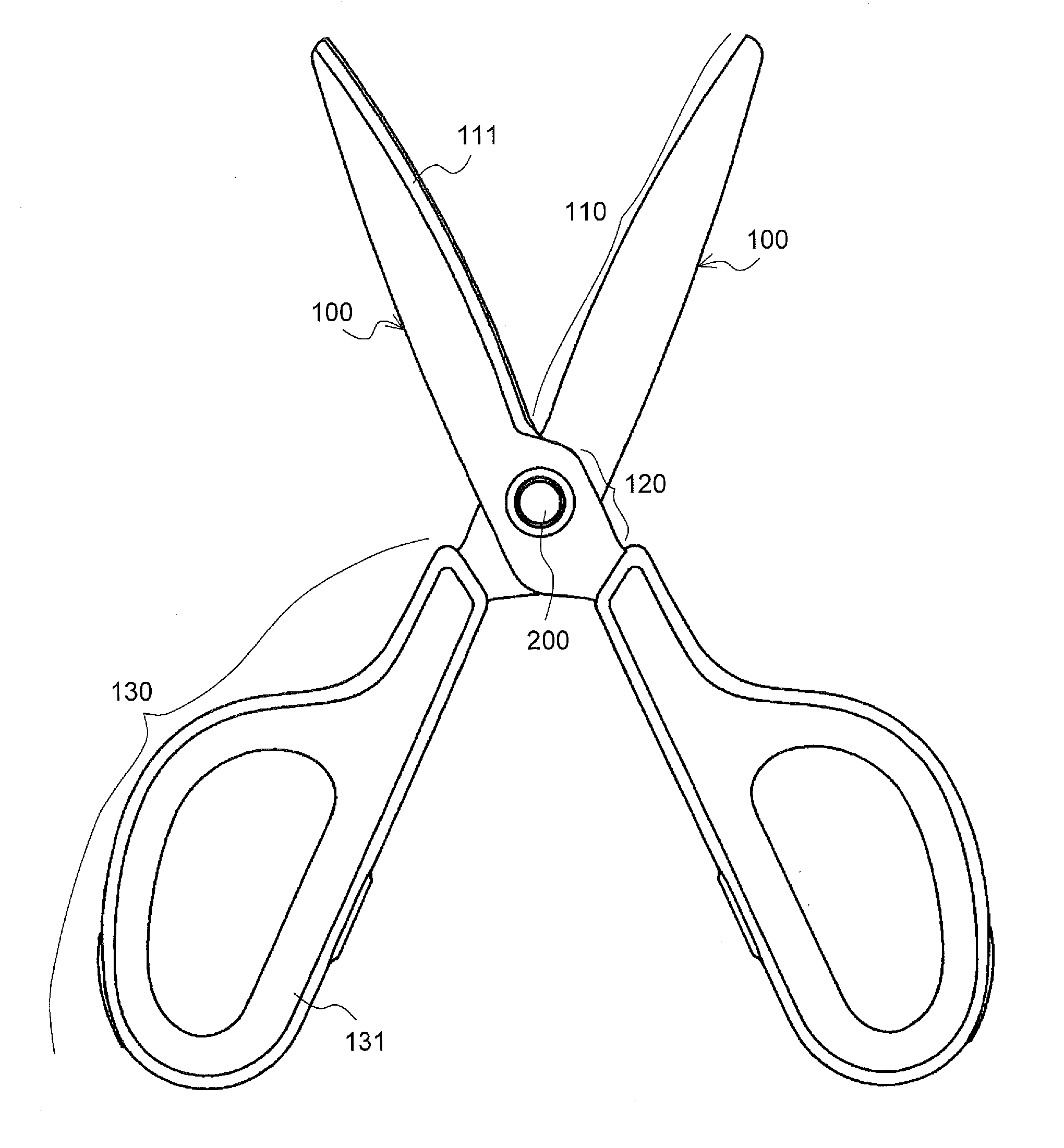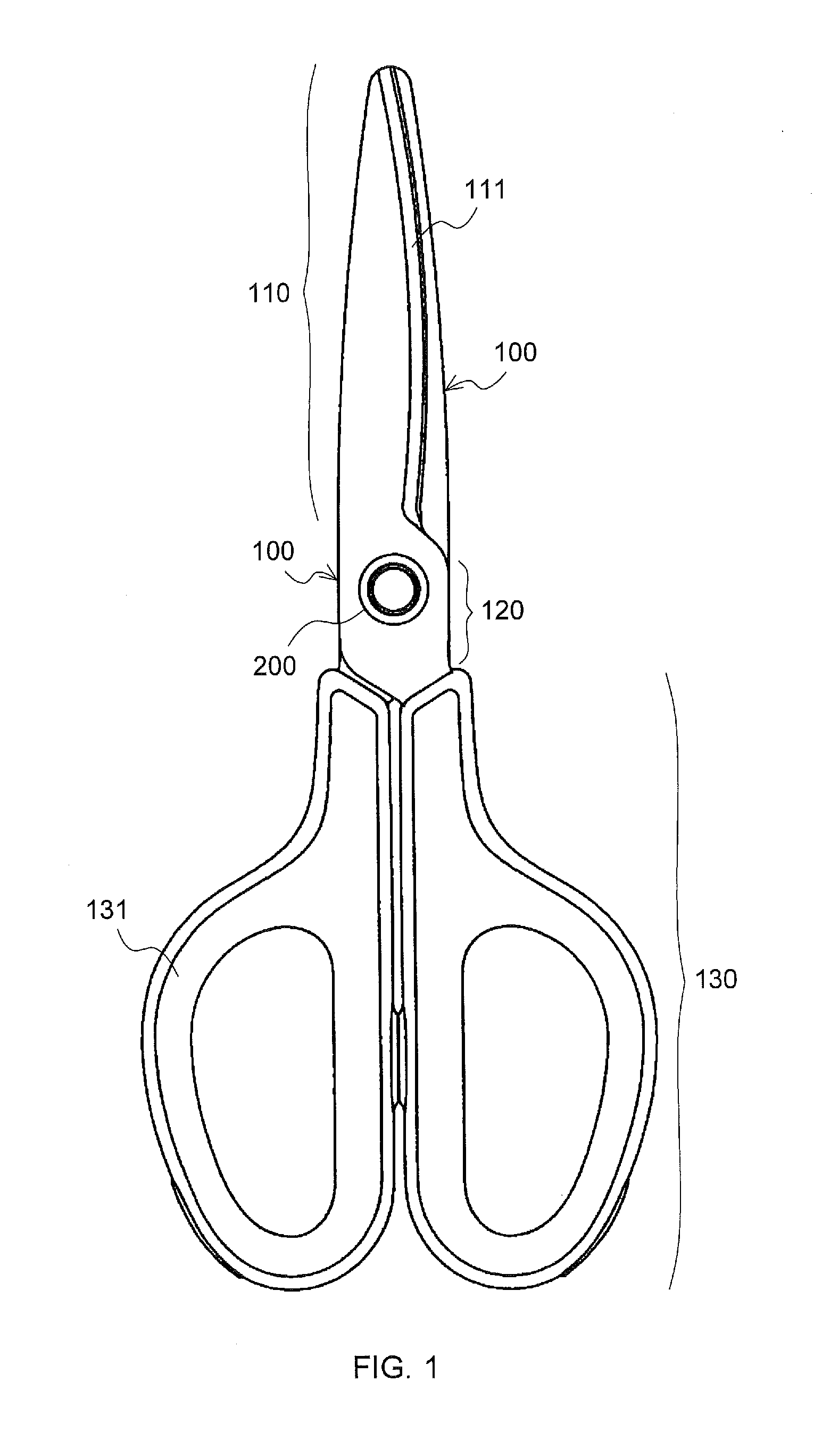Scissors
- Summary
- Abstract
- Description
- Claims
- Application Information
AI Technical Summary
Benefits of technology
Problems solved by technology
Method used
Image
Examples
first embodiment
[0052]FIGS. 1 and 2 are plan views of a pair of scissors according to a first embodiment of the present invention in which cutting members described below are in their closed and opened positions, respectively, and FIG. 3 is a side view of the same scissors.
[0053]The scissors have two cutting members 100.
[0054]Each cutting member 100 includes a blade 110 at the distal side thereof, a joint region 120, and a handle 130 at the proximal side thereof.
[0055]The two cutting members 100 are pivotally joined at a joint assembly 200 in the joint region 120. In other words, the cutting members 100 can slide against each other on the joint assembly 200. How the joint regions 120 of the two cutting members 100 are joined together using the joint assembly 200 is described later.
[0056]The blades 110 are made of, for example, metal. Each blade 110 of an elongated plate-like shape comprises an edge 111. The edge 111 extends along the entire length of the blade 110 on the fore side thereof. The edge...
second embodiment
[0095]A pair of scissors of the second embodiment is basically identical the one in the first embodiment.
[0096]The pair of scissors of the second embodiment includes two cutting members similar to those described in the first embodiment. The two cutting members are joined together and can pivotally move on the joint assembly.
[0097]The cutting members of the scissors of the second embodiment are identical to those in the first embodiment in that each cutting member includes a blade, a joint region and a handle and that the blade has a curved edge and the handle has a grip. The contact-free parts are formed in the respective cutting members and the areas where the contact-free parts are provided are identical to those in the first embodiment.
[0098]The only difference between the scissors in the second embodiment and the scissors in the first embodiment lies in the cross-sectional shape of the cutting member bodies.
[0099]The outer surface and the inner surface of the cutting member are...
third embodiment
[0110]A pair of scissors of the third embodiment is basically identical to the one in the first embodiment.
[0111]The pair of scissors of the third embodiment includes two cutting members similar to those described in the first embodiment. The two cutting members are joined together and can pivotally move on the joint assembly.
[0112]The cutting members of the scissors of the third embodiment are identical to those in the first embodiment in that each cutting member includes a blade, a joint region and a handle and that the blade has a curved edge and the handle has a grip. The contact-free parts are formed in the respective cutting members and the outer surface and the inner surface of each cutting member body are parallel to each other, as in the first embodiment.
[0113]The only difference between the scissors in the third embodiment and the scissors in the first embodiment lies in coverage of the contact-free parts.
[0114]The contact-free parts 140 in the first embodiment are formed ...
PUM
 Login to View More
Login to View More Abstract
Description
Claims
Application Information
 Login to View More
Login to View More - R&D
- Intellectual Property
- Life Sciences
- Materials
- Tech Scout
- Unparalleled Data Quality
- Higher Quality Content
- 60% Fewer Hallucinations
Browse by: Latest US Patents, China's latest patents, Technical Efficacy Thesaurus, Application Domain, Technology Topic, Popular Technical Reports.
© 2025 PatSnap. All rights reserved.Legal|Privacy policy|Modern Slavery Act Transparency Statement|Sitemap|About US| Contact US: help@patsnap.com



